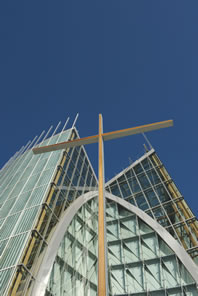Inauguration of the new Oakland cathedral
Constructed over the last three years, Oakland’s newest cathedral held an inaugural concert Sunday evening, Nov. 2, with the Oakland Symphony and Symphony Chorus. Rising like a glass ship at the edge of Lake Merritt, the huge Cathedral of Christ the Light is the headquarters for the Oakland Catholic Diocese.
Offices and outreach programs are housed in the immense concrete lower level, including a health clinic for those without insurance. Along with 200 parking spaces the building holds a mausoleum with 1,300 crypts and 1,450 niches, parking for all seasons.
Services began over a month ago, but Sunday afternoon the mausoleum held its first internment, the Most Reverend Floyd Begin, Oakland’s first bishop.
Michael Morgan, conductor of the Oakland Symphony, greeted the capacity crowd and urged them to pack more tightly in the pews as latecomers streamed in. The cathedral intends to open this space for concerts, and its magnificent acoustics, designed for church choirs, creates an excellent venue. Oak pews, however, reminded one of the self-flagellation practiced by some monks, numbing the nether regions to conserve blood flow to the brain. But as solid oak goes, these were comfortable enough and would give the lower back-cramping SF Opera seats a run for their money.
Bruckner’s brief choral motet, “Locus Iste,” also written for a church’s dedication, opened the program.
The singers’ harmonies echoed back from wooden shutters, arching between huge glu-lam ribs 100 feet into the air. The slats curved progressively over as they rose, reflecting the sound like a parabolic lens. The superstructure sat atop a massive 12-foot-high concrete wall, which added sharper echoes to the cavernous mix.
 The sopranos were often in a “sweet spot,” echoing long after the notes were sung. Although the acoustics blurred the consonants, the singing was so tight on pitch that vowels kept a lovely clarity.
The sopranos were often in a “sweet spot,” echoing long after the notes were sung. Although the acoustics blurred the consonants, the singing was so tight on pitch that vowels kept a lovely clarity.
Immense crucifixes, electric “candelabra,” a crypt below and ghostly echoes above gave the concert a primitive power.
Brahms’ Serenade No. 2 followed, an opportunity to hear how instruments would fare in the space. Even though I was seated to one side, waves of sound completely surrounded me, a medium one could almost swim in. It was an extraordinary sensation, and I hope more concerts will follow.
The thrum of basses reverberated over the orchestra, a satisfying kick to the lower frequencies. Morgan’s reduced orchestra had no violins, following Brahms’ scoring, but was rich with violas and winds. Descending patterns looped through the orchestra, indistinct and murmuring. Clarinets rang out, horns answering with a stately tonic-fourth-dominant in majestic A major. A lively use of horns for “the hunt” movement tripped along in a perky minuet.
But the big Brahms moment came in the slow Adagio, basses crossing flutes with sad majesty and tension, then building density to a thick sustain. The final chord resolved to strings above and horns below, absorbing its echoes and dying magnificently.
After an intermission Morgan called us back for Gabriel Fauré’s Requiem, a gem of the choral repertoire. The Oakland Symphony Chorus, carefully prepared by Dr. Lynne Morrow, was expressive in Morgan’s hands. Reiterating the organ’s minor, they sowed glimpses of their power, then ended the Kyrie with a long-held pianissimo chord, softly penetrating the hall.
Baritone Zachary Gordin entered in the Offertoire, his voice carrying while free of vibrato like a Gregorian chant. The chorus and orchestra moved back to major for the triumphant Sanctus, harpist Natalie Cox opening the way. Terrie Baune’s violin solo was sweet and high, ending with trills, then swelling and fading.
Soprano Heidi Moss sang the well-known Pie Jesu solo with amber tones, a mouth-filling sound that was almost mezzo, echoing from the walls. The hall became grotto as this siren sang to us of death.
The chorus showed its muscle in the Agnus Dei, then sent us home gently In Paradisum, in paradise.
—Adam Broner
This article originally appeared in the Piedmont Post
